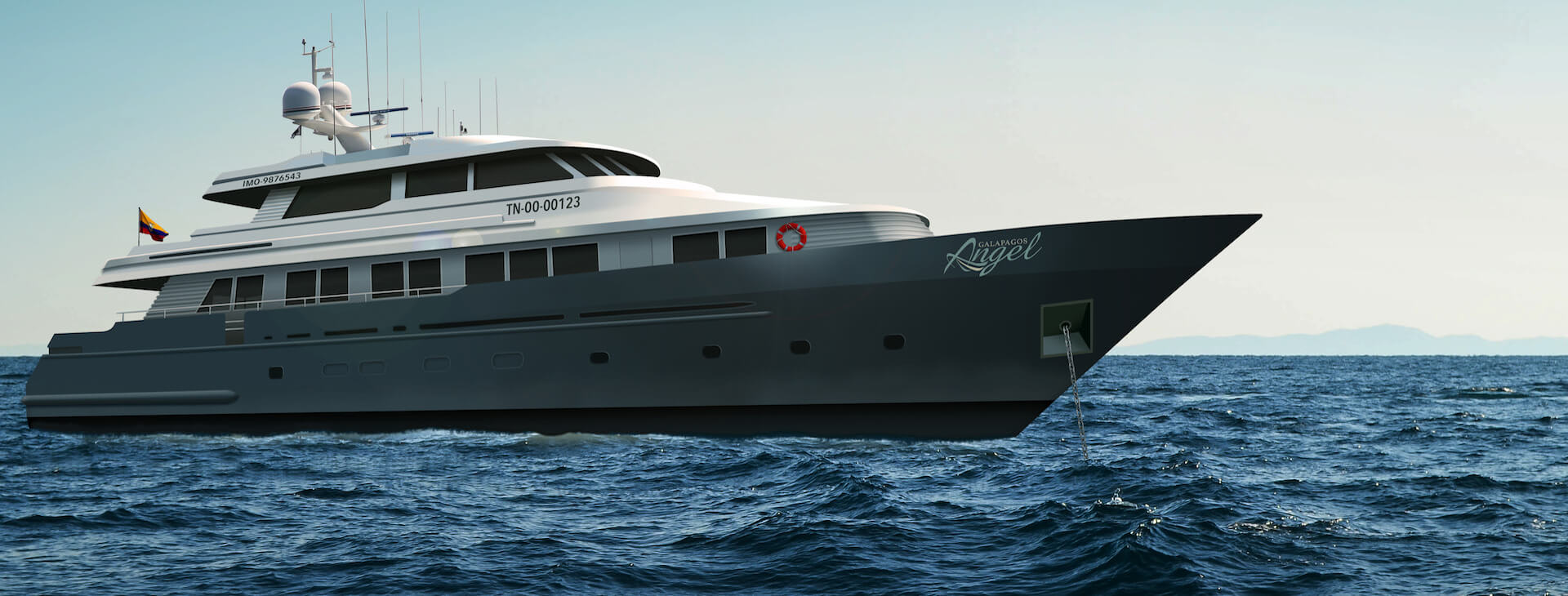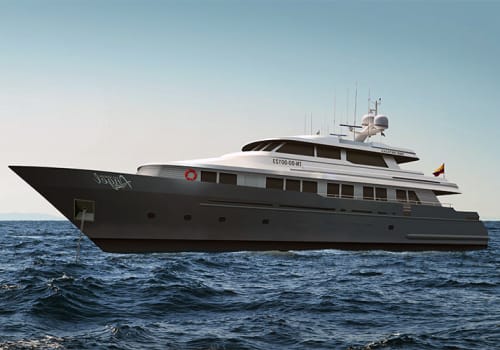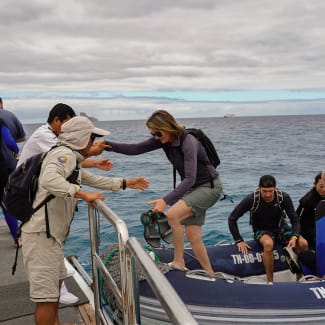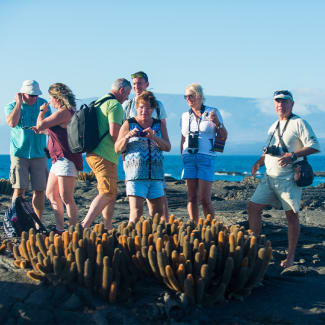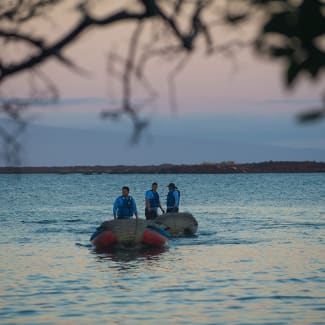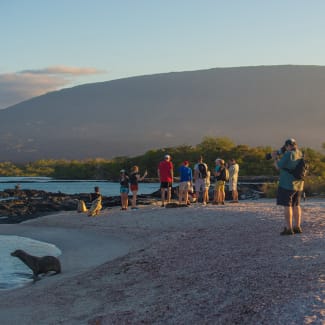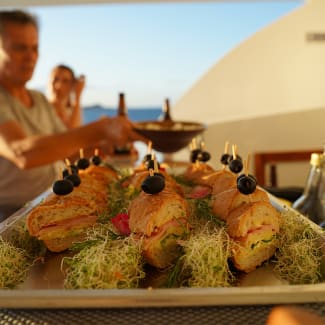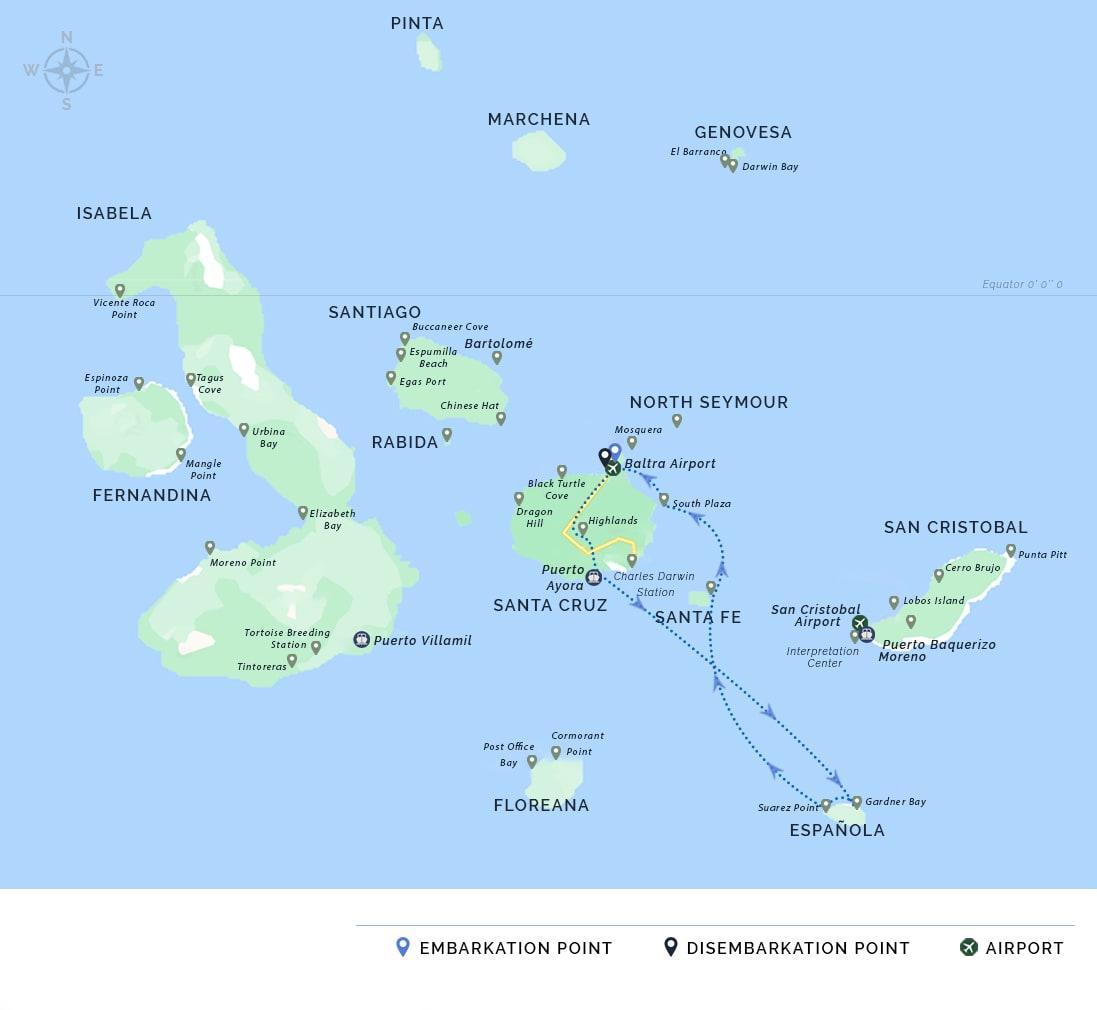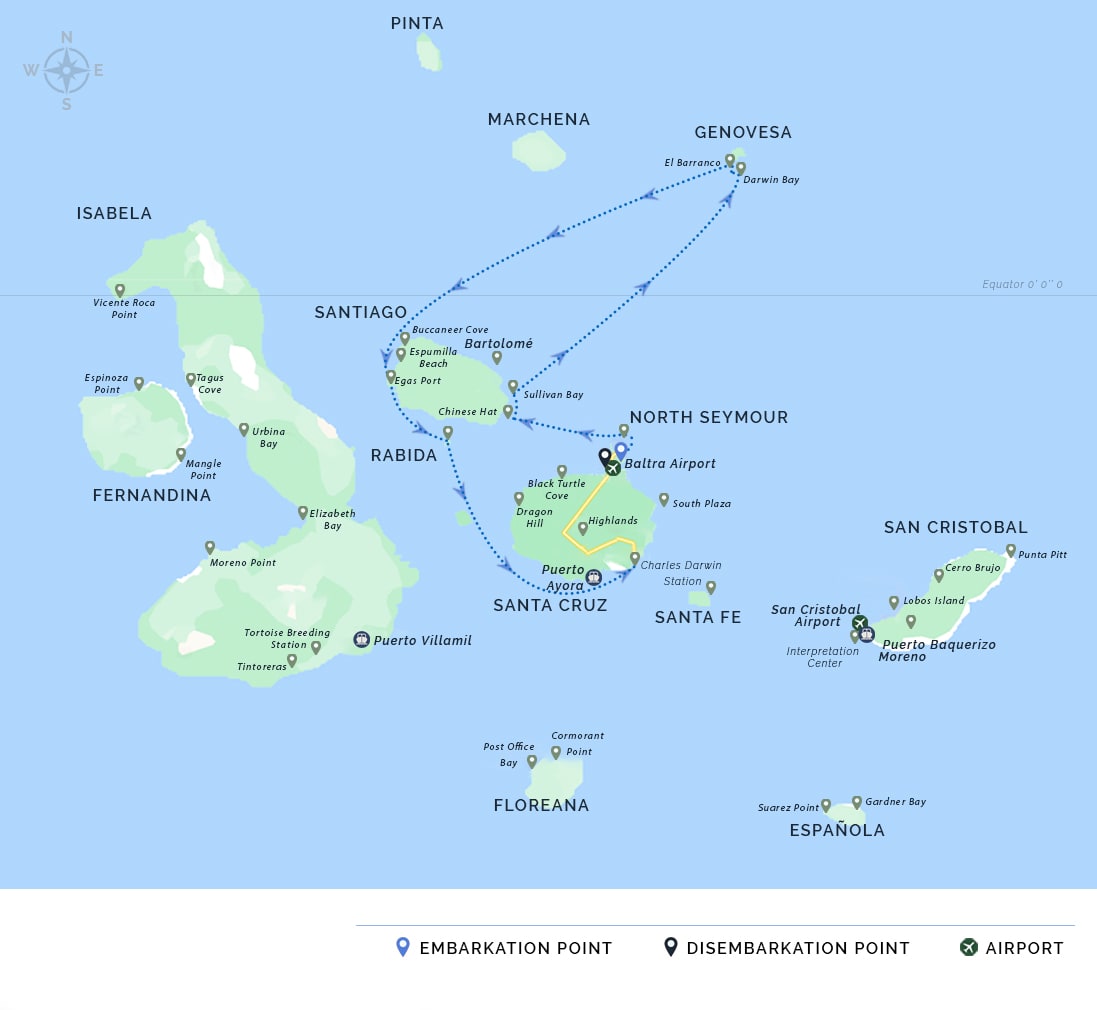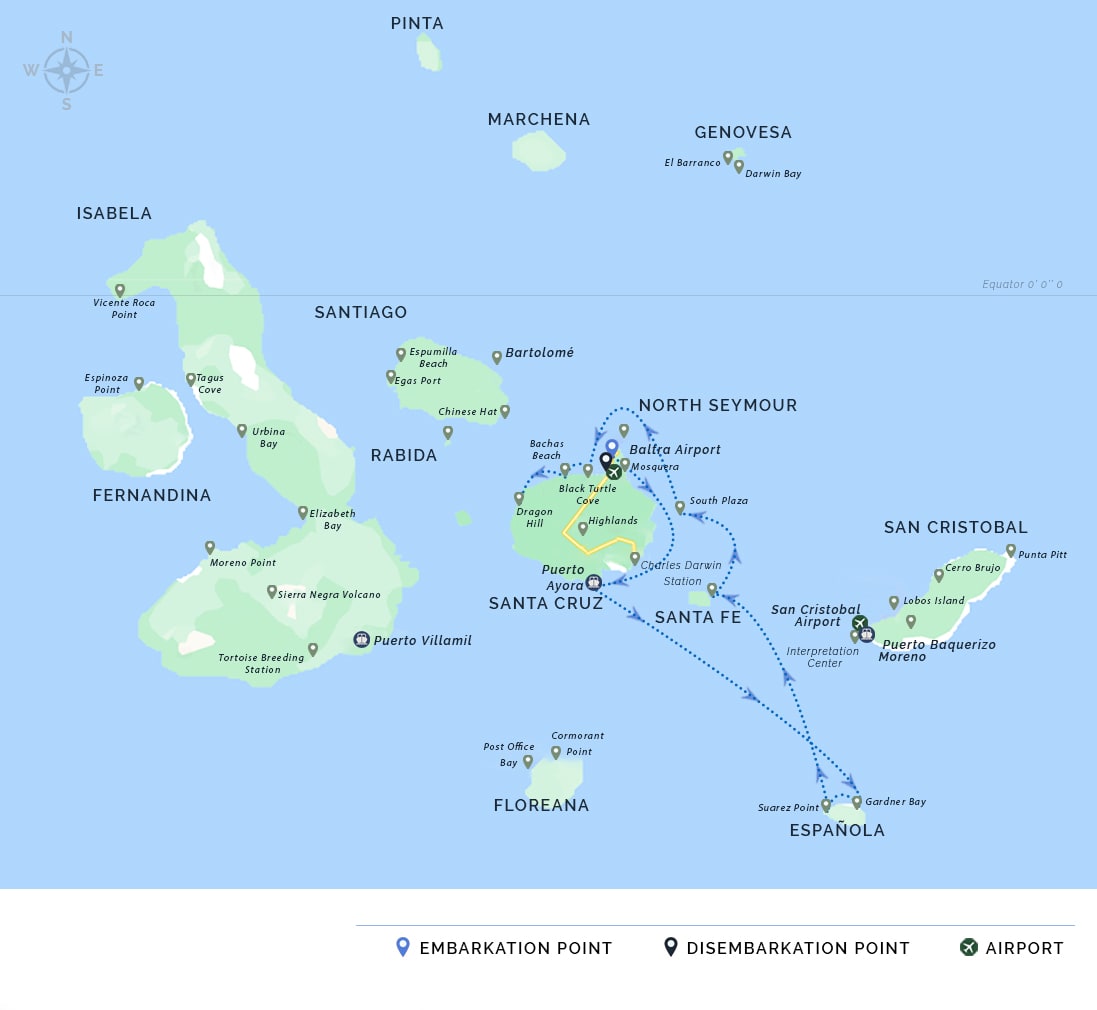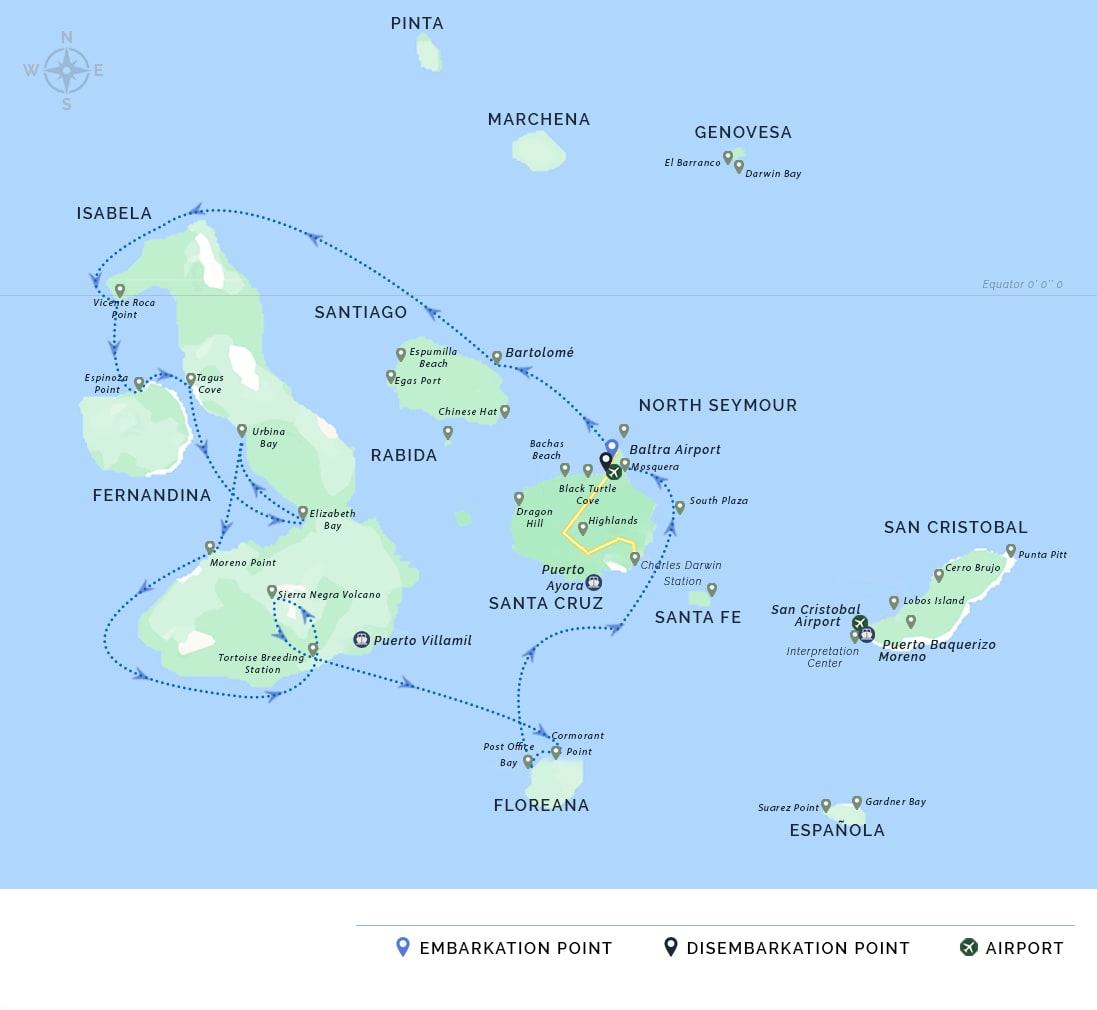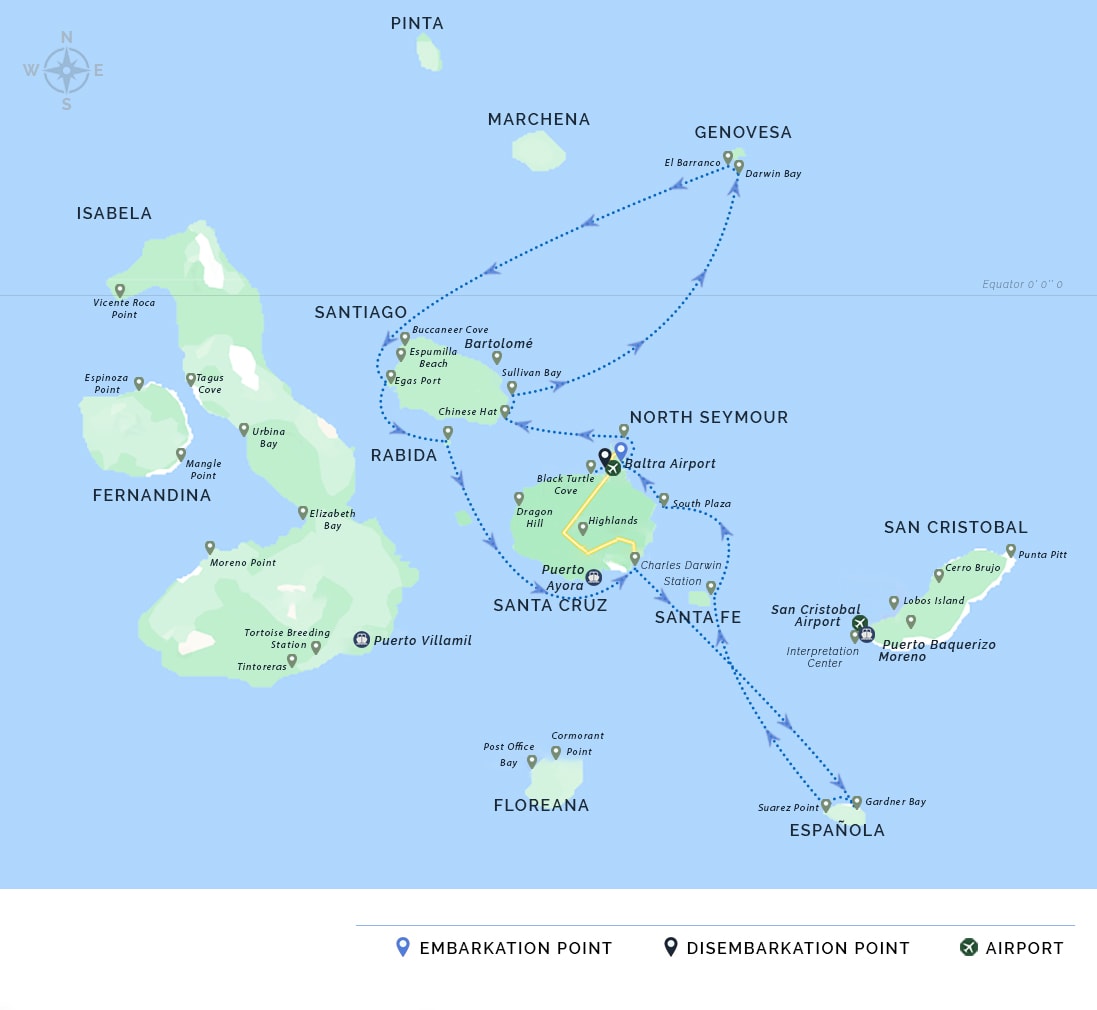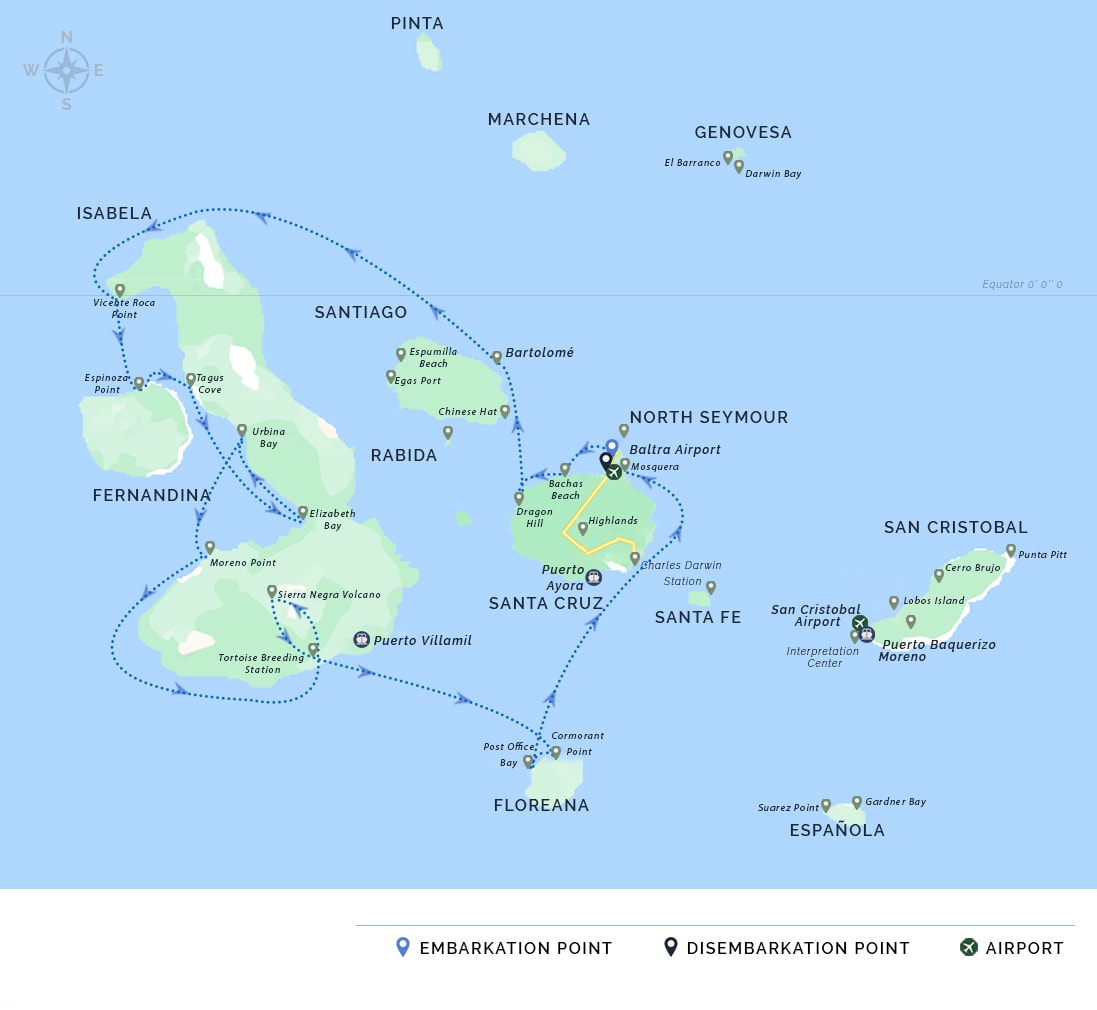Overview
One of the newest motor yachts exploring the Enchanted Isles, the 16-guest Galapagos Angel offers a unique blend of adventure, comfort, and exclusivity. Crafted with precision in the Netherlands, she embodies the elegance of classical Europe while delivering the highest navigation standards, and promises a first class experience as you explore the wonders of the Galapagos Archipelago.
Life On Board
The Galapagos Angel boasts two large suites on the upper deck and six slightly smaller cabins on the main deck, accommodating a maximum of 16 passengers in total. Revel in the comfort of thoughtfully designed accommodations, featuring panoramic windows that offer breathtaking views of the surrounding beauty, and stay connected with loved ones using the onboard WiFi service, ensuring you can share every awe-inspiring moment of your journey.
Relax and unwind in the upper deck’s stylish bar and alfresco dining area, or head to the main deck’s cozy dining room and lounge. Above, the sun deck beckons with a Jacuzzi, ample seating, and sun beds, providing the perfect vantage point to soak in the Galapagos’ natural wonders.
Exciting Exploration
Leave the details to the expert crew members and your certified bilingual naturalist guide. They will guide you through the islands, showcasing the most remarkable spots and ensuring an unforgettable, immersive experience.
Lucky guests can choose from four carefully curated itineraries that capture the essence of the Galapagos Islands; 4-day and 5-day itineraries discovering the diverse beauty and unique flora and fauna of the archipelago’s more central islands, plus Española or Genovesa respecively; an 8-day (A) itinerary combining both these itineraries; or an equally thrilling 8-day (B) itinerary exploring the wonders of the western islands of Isabela and Fernandina, alongside the mysterious Floreana with its intriguing human history.
Embark on a journey like no other, where every detail is crafted to ensure your Galapagos experience is nothing short of extraordinary. Ideal for families, groups, and private charters, the Galapagos Angel awaits to indulge explorers of all kinds with its exciting and elegant expeditions.
Itineraries & Prices
All itineraries are subject to change due to seasonal weather conditions (and resultant variations in river and tributary water levels) affecting accessibility to locations. Thus navigation routes, times and excursions may need to be modified at the cruise captain’s or your guide's discretion.
Embarkation
AM: Morning flight to Baltra. After passing through immigration and baggage claim, you will be met by a Galapagos Angel staff member and brought into a private bus to start your adventure in Galapagos.
The first excursion will be after being picked up at the airport upon arrival to the islands, so it is advisable to travel with suitable clothing and footwear for walking.
PM: Accessible by bus from Puerto Ayora, the highlands of Santa Cruz are a deep green which contrasts beautifully with the dry, lower part of the islands. The predominant vegetation in the highlands are Scalesia trees which create a lush green forest. The lava tunnels, over half a mile long, are underground; walking through them is a unique, surreal experience. At this place you’ll have lunch.

Suarez Point & Gardner Bay
AM: On the trail to Suarez Point you will have the chance to spot blue-footed boobies, albatrosses, and Nazca boobies. This island is the breeding site of nearly all of the world’s 12,000 pairs of waved albatrosses. You will also visit a beautiful site on the oceanfront where there is a cliff that the large albatrosses use as a launching pad! You will have the chance to see the famous blowhole that spurts sea water into the air. The landscape is great for photography.
PM: This excursion takes you to the spectacular Gardner Bay. After landing, you can walk across a lovely white-sand beach amongst a busy sea lion colony or dive into the water to swim with sea lion pups. You may also see curious mockingbirds on the beach.
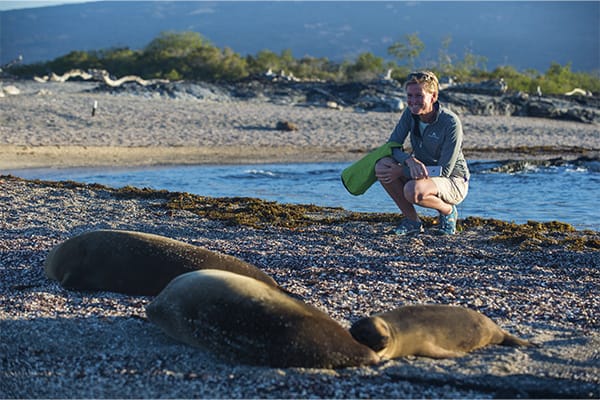
Santa Fe & South Plaza
AM: Santa Fe Island (Barrington) is home to the small picturesque bay and anchorage on the island’s northeast coast. The bay has two visitor trails: one leading to a scenic viewpoint atop a cliff, and the other spanning from a small beach to a tall prickly pear cactus forest.
PM: This small island with steep cliffs was formed by rising lava and is now covered by Opuntia cacti. It is also home to one of the largest sea lion colonies as well as colorful yellow and red land iguanas. The most characteristic plant is the Sesuvium. During the rainy season its color is a greenish to yellowish tone and in the dry season (end of June through January) a bright red.
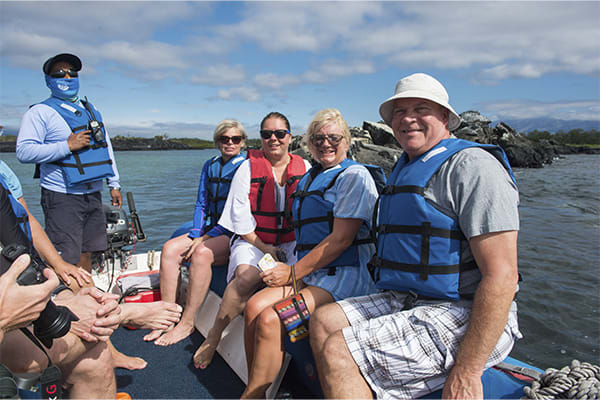
Disembarkation
AM: Visit Black Turtle Cove in the northern part of Santa Cruz. This inlet is surrounded by mangroves and is only accessible by dinghy. The shallow cove is a haven for young marine life. Black-tip and white-tip reef sharks, sea turtles, and a variety of rays are often spotted here.
After this final visit, you will be transferred to the Baltra airport in time for your flight back to the mainland.

Embarkation
AM: Morning flight to Baltra, Galapagos Islands. You will arrive at Baltra Island in the morning. After passing through immigration and baggage claim, you will be met by a Galapagos Angel staff member and transferred to the yacht. You will be shown to your cabin where you will have some time to settle in before lunch and a welcome briefing.
PM: In North Seymour, you may see Galapagos sea lions, blue-footed boobies, and magnificent frigate birds which are abundant on this island. North Seymour was formed by a series of submarine lava flows containing layers of sediment that were uplifted by tectonic activity. The island is characterized by its arid vegetation zone.
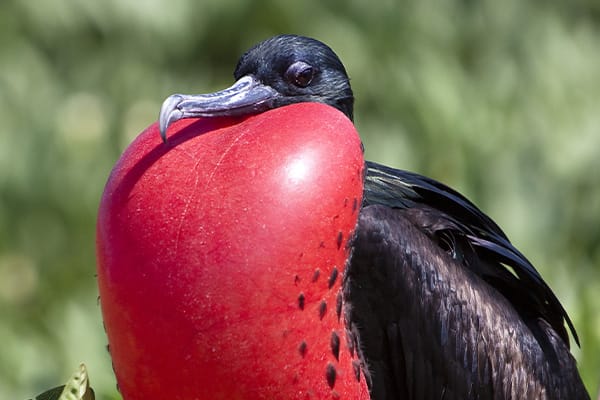
Chinese Hat & Pinnable Rock
AM: This small islet is located near the southeast coast of Santiago Island. Its name comes from the distinct shape of the islet’s summit. Chinese Islet is a great location to view many geological formations such as lava tunnels and lava flows. Some of the lava flows were formed underwater and subsequently raised above sea level. The presence of coral heads on the lava flow indicates this phenomenon.
PM: You will head to Bartholomew Island where the famous Pinnacle Rock is found. Bartholomew consists of an extinct volcano with a variety of red, orange, black and even green volcanic formations. We will take a trail of stairs to the summit of the volcano (about 30 or 40 minutes) where you will enjoy one of the best views of the islands! You will also visit a small, beautiful beach surrounded by the only vegetation found on this barren island. The beach is perfect for snorkeling where you may even see and swim with Galapagos penguins.
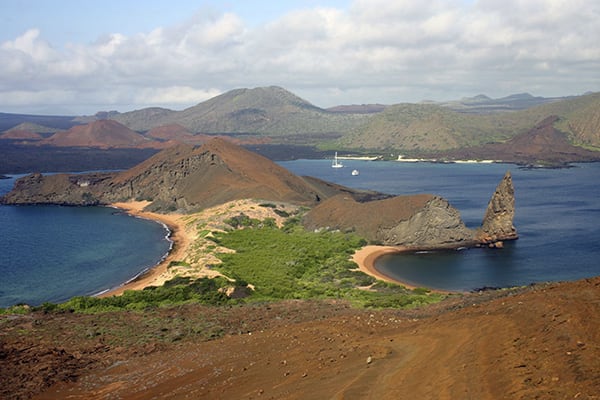
Darwin Bay & El Barranco
AM: Visit the white-sand coral beach of Darwin Bay which includes a half mile trail (0,75km) that winds through mangroves filled with land birds. Nazca boobies, red-footed boobies, and swallow-tailed gulls, which can easily be spotted here. Further down the path we’ll find tidal pools where sea lions swim playfully. At the end is a spectacular view of a cliff.
PM: El Barranco, also known as Prince Phillip’s Steps, is a steep, rocky path that leads up a high cliff rock face. A marvelous view can be appreciated from here. This site is also home to Palo Santo vegetation as well as red-footed boobies, short-eared owls, Galapagos storm petrels, and Galapagos doves.

Egas Port & Rabida Island
AM: Egas Port, also known as James Bay, on Santiago Island is home to the curious Galapagos hawks and quick-footed Galapagos lava lizards. The trail leads to the coastline with gorgeous tide pools and grottos full of fauna. Here the Galapagos furseals bathe in the sun. This is also a great snorkeling site.
PM: You will visit Rabida Island (or Jervis) which is one of the most colorful and volcanically varied islands in the archipelago as well as a great snorkeling site. We will start on Rabida’s famous maroon/red sand beach, and after an easy hike, you will arrive to a stunning lookout to enjoy the amazing landscapes. The island is a birdwatcher’s delight. Some species are abundant such as a few varieties of finches, Galapagos vermilion flycatchers, Galapagos hawks, and brown pelicans.

Disembarkation
AM: You will visit “Fausto Llerena” Tortoise Breeding Center in Puerto Ayora, where giant tortoises are bred in captivity. This is home to tortoises ranging from 3 inches (new hatchlings) to 4-foot-long adults. Subspecies of the giant tortoises interact with one another, and many of the older tortoises are accustomed to humans stretching out their heads for a photo opportunity. The babies are kept until they are bout four years old and strong enough to survive on their own.
After this final visit, you will be transferred to the Baltra airport in time for your flight back to the mainland.
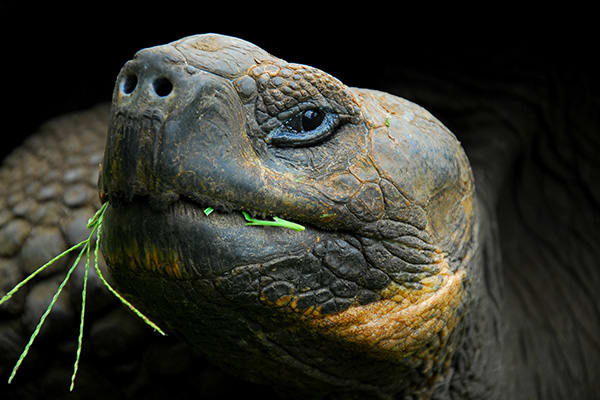
Embarkation Day
AM: Morning flight from Quito or Guayaquil to Baltra, Galapagos Islands. After passing through immigration and baggage claim, you will be met by a Galapagos Angel staff member and brought into a private bus to start your adventure in Galapagos.
PM: Accessible by bus from Puerto Ayora, the highlands of Santa Cruz are a deep green which contrast beautifully with the dry, lower part of the islands. The predominant vegetation in the highlands are Scalesia trees which create a lush green forest. The lava tunnels, over half a mile long, are underground and walking through them is a unique, surreal experience. At this place you’ll have lunch.
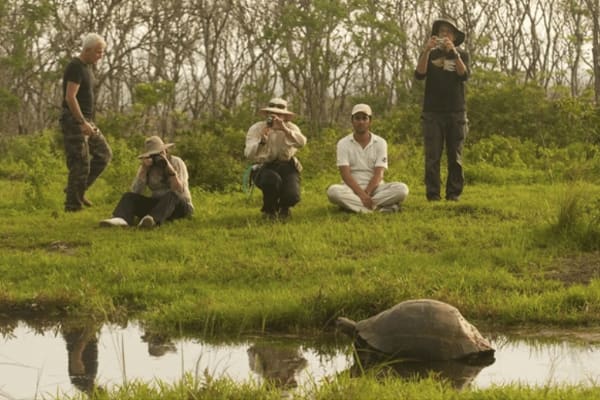
Gardner Bay & Suarez Point
AM: This excursion takes you to the spectacular Gardner Bay. After landing, you can walk across a lovely white-sand beach amongst a busy sea lion colony or dive into the water to swim with sea lion pups. You may also see curious mockingbirds on the beach.
PM: On the trail to Suarez Point you will have the chance to spot blue-footed boobies, albatrosses, and Nazca boobies. This island is the breeding site of nearly all of the world’s 12,000 pairs of waved albatrosses. You will also visit a beautiful site on the ocean front where there is a cliff that the large albatrosses use as a launching pad! You will have the chance to see the famous blowhole that spurts sea water into the air. The landscape is great for photography.

Santa Fé & South Plaza
AM: Santa Fe Island (Barrington) is home to the small picturesque bay and anchorage on the island’s northeast coast. The bay has two visitor trails: one leading to a scenic viewpoint atop a cliff, and the other spanning from a small beach to a tall prickly pear cactus forest.
PM: This small island with steep cliffs was formed by rising lava and is now covered by Opuntia cacti. It is also home to one of the largest sea lion colonies as well as colorful yellow and red land iguanas. The most characteristic plant is the Sesuvium. During the rainy season its color is a greenish to yellowish tone and in the dry season (end of June through January) a bright red.

Black Turtle Cove & Bachas Beach
AM: Visit Black Turtle Cove in the northern part of Santa Cruz. This inlet is surrounded by mangroves and is only accessible by dinghy. The shallow cove is a haven for young marine life. Black-tip and white-tip reef sharks, sea turtles, and a variety of rays are often spotted here.
PM: Bachas Beach is located on the north shore of Santa Cruz and is a beach for swimming. One of the few remnants of the U.S. World War II presence in the Galapagos, a floating pier, can be seen here. You may see flamingos, Sally Lightfoot crabs, hermit crabs, black-necked stilts, and whimbrels. Sea turtles also nest on the beach.
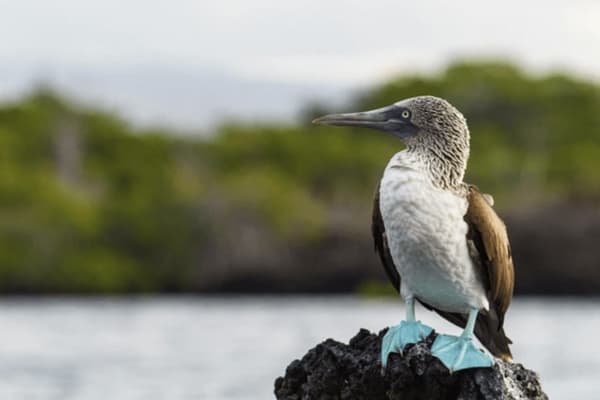
Disembarkation
AM: Situated on Santa Cruz Island, Dragon Hill is one of the newest visitor sites accessible to tourists in the Galapagos Islands. One of the lengthier Galapagos walking trails will lead visitors along a beach and up a trail to the lagoon lookout where bright flamingos, pintail ducks, and land iguanas can be spotted.
After this final visit, you will be transferred to the Baltra airport in time for your flight back to the mainland.

Embarkation
AM: You will arrive at Baltra Island in the morning. After passing through immigration and baggage claim, you will be met by a Galapagos Angel staff member and transferred to the yacht. You will be shown to your cabin where you will have some time to settle in before lunch and a welcome briefing.
PM: You will head to Bartholomew Island where the famous Pinnacle Rock is found. Bartholomew consists of an extinct volcano with a variety of red, orange, black and even green volcanic formations. We will take a trail of stairs to the summit of the volcano (about 30 or 40 minutes) where you will enjoy one of the best views of the islands! A beautiful beach surrounded by the only vegetation is perfect for snorkeling where you may even see and swim with Galapagos penguins.

Vicente Roca Point & Espinoza Point
AM: Comprised of two separate coves, Vicente Roca Point is a large bay with spectacular sea life. Keep an eye out for seahorses, sea turtles, and the strange yet fascinating Mola mola (or sun fish) while you snorkel.
PM: Crossing the Bolivar Channel that divides Isabela and Fernandina Islands, you will land at Espinoza Point, and after walking past a colony of marine iguanas and a group of sea lions, you will reach the island’s highlight: the flightless cormorant nesting site. This area also provides a great opportunity to see the Galapagos hawk.

Tagus Cove & Elizabeth Bay
AM: You will visit Tagus Cove on Isabela Island which is located across from Fernandina Island, near the Bolivar Channel dividing the two islands. This spot has been frequented by ships since the 1800s, using the area as an anchorage site. Trails winding by Lake Darwin up to a ridge display wonderful views.
PM: Elizabeth Bay is located on the east coast of Isabela Island. The bay contains many islets, which can be visited by dinghy. Penguins and blue-footed boobies can be spotted on the rocky islets. With an abundance of marine life and clear water, the area is perfect for snorkeling and viewing schools of colorful fish, sea lions, and perhaps even sharks.
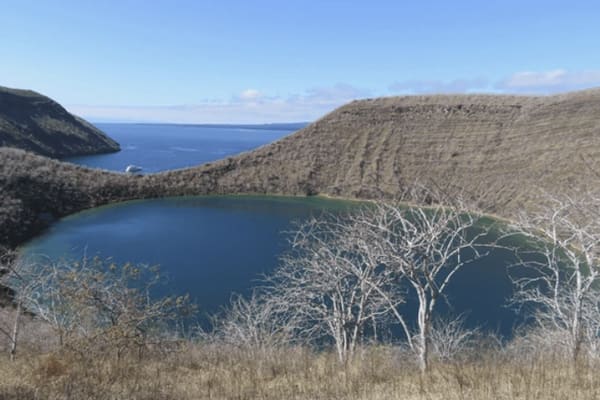
Urbina Bay & Moreno Point
AM: Urbina Bay is located at the base of Alcedo Volcano on the west coast between Tagus Cove and Elizabeth Bay. This area experienced a major uplift in 1954 causing the land to rise over 16 feet. The coast expanded half a mile out leaving marine life stranded on the new shore. This area is also a great place for snorkeling.
PM: Moreno Point is located southwest of Elizabeth Bay. Here a dry landing onto what was once flowing lava is possible. The lava has left craters in its wake which formed crystal tide pools. By looking into the pools, you can peer into another world as the marine life drifts by your window. In the brackish pools of this area, you may see pink flamingos, white-cheeked pintails, and common gallinules. If you look carefully into the pools, you may see white-tip reef sharks and some sea turtles.

Sierra Negra Volcano & Tortoise Breeding Cente
AM: Visit to the Sierra Negra Volcano, which is the largest basaltic caldera in the Galapagos with a diameter of 6.2 miles (10 km). The site offers impressive views and the opportunity to observe up to seven species of finches and a rich display of vegetation. The north side of the caldera provides evidence of its most recent volcanic activity in 2005.
PM: Arnaldo Tupiza Breeding Center is located about one mile (1.5 km) from Puerto Villamil. Here, tortoise populations from South Isabela, Sierra Negra Volcano, Cerro Azul, Cazuela, Cinco Cerros, Roca Union, San Pedro, Tables and Cerro Paloma have been bred in captivity. In total there are 330 juvenile and adult tortoises.
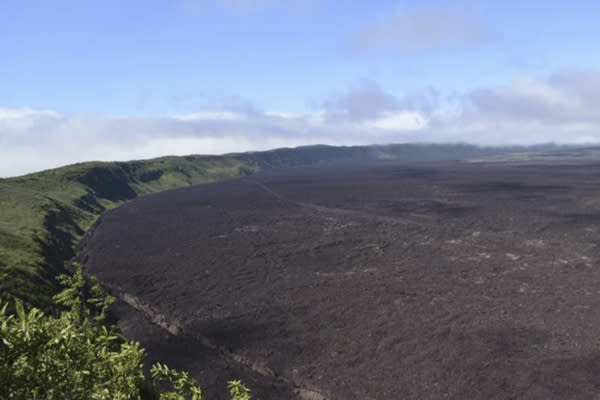
Devil’s Crown, Cormorant Point & Post Office Bay
AM: You will have a chance to snorkel around Devil’s Crown which is the rocky remains of an offshore volcano sticking out of the water. This is a great location to spot a wide range of marine creatures.
Cormorant Point hosts a large flamingo lagoon where other birds such as common stilts and white-cheeked pintails can also be seen. The beaches on this island are distinct: The Green Beach is named so due to its green color, which comes from a high percentage of olivine crystals in the sand, and the Flour Sand Beach is composed of white coral.
PM: You will land on a beach and head to a spot where 18th century whalers placed a wooden barrel used as an unofficial mail box. The custom continues to this day with Galapagos visitors. So, don’t forget your postcards, and don’t be surprised if the post card arrives to its destination before you even get home!

Disembarkation
AM: Mosquera Islet is located between the islands of Baltra and North Seymour. This reef of rocks and coral (the result of an uprising) is only 160 meters across at its narrowest width. This island has one of the largest populations of sea lions and is home to many shorebirds. There have been occasional reports at this site of orcas feeding on sea lions.
After this final visit, you will be transferred to the Baltra airport in time for your flight back to the mainland.
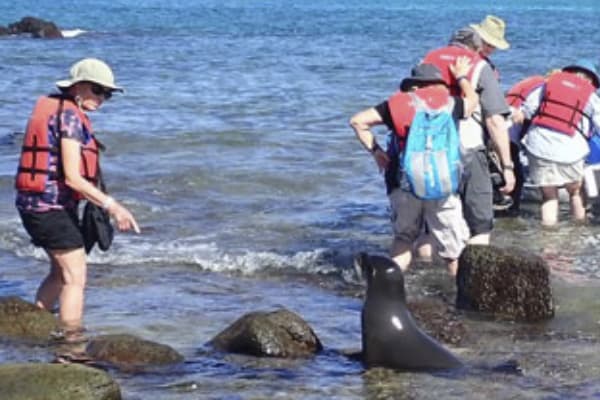
Embarkation
AM: You will arrive at Baltra Island in the morning. After passing through immigration and baggage claim, you will be met by a Galapagos Angel staff member and transferred to the yacht. You will be shown to your cabin where you will have some time to settle in before lunch and a welcome briefing.
PM: In North Seymour you may see Galapagos sea lions, blue-footed boobies, and magnificent frigate birds which are abundant on this island. North Seymour was formed by a series of submarine lava flows containing layers of sediment that were uplifted by tectonic activity. The island is characterized by its arid vegetation zone.

Chinese Hat & Pinnacle Rock
AM: This small islet is located near the southeast coast of Santiago Island. Its name comes from the distinct shape of the islet’s summit. Chinese Islet is a great location to view many geological formations such as lava tunnels and lava flows. Some of the lava flows were formed underwater and subsequently raised above sea level. The presence of coral heads on the lava flow indicates this phenomenon.
PM: You will head to Bartholomew Island where the famous Pinnacle Rock is found. Bartholomew consists of an extinct volcano with a variety of red, orange, black and even green volcanic formations. We will take a trail of stairs to the summit of the volcano (about 30 or 40 minutes) where you will enjoy one of the best views of the islands! You will also visit a small, beautiful beach surrounded by the only vegetation found on this barren island. The beach is perfect for snorkeling where you may even see and swim with Galapagos penguins.

Darwin & El Barranco
AM: Visit the white-sand coral beach of Darwin Bay which includes a half-mile trail (0,75km) that winds through mangroves filled with land birds. Nazca boobies, red-footed boobies, and swallow-tailed gulls, which can easily be spotted here. Further down the path we’ll find tidal pools where sea lions swim playfully. At the end is a spectacular view of a cliff.
PM: El Barranco, also known as Prince Phillip’s Steps, is a steep, rocky path that leads up a high cliff rock face. A marvelous view can be appreciated from here. This site is also home to Palo Santo vegetation as well as red-footed boobies, short-eared owls, Galapagos storm petrels, and Galapagos doves.

Egas Port & Rabida Island
AM: Egas Port, also known as James Bay, on Santiago Island is home to the curious Galapagos hawks and quick-footed Galapagos lava lizards. The trail leads to the coastline with gorgeous tide pools and grottos full of fauna. Here the Galapagos fur seals bathe in the sun. This is also a great snorkeling site.
PM: You will visit Rabida Island (or Jervis) which is one of the most colorful and volcanically varied islands in the archipelago as well as a great snorkeling site. We will start on Rabida’s famous maroon/red sand beach, and after an easy hike, you will arrive to a stunning lookout to enjoy the amazing landscapes. The island is a birdwatcher’s delight. Some species are abundant such as a few varieties of finches, Galapagos vermilion flycatchers, Galapagos hawks, and brown pelicans.
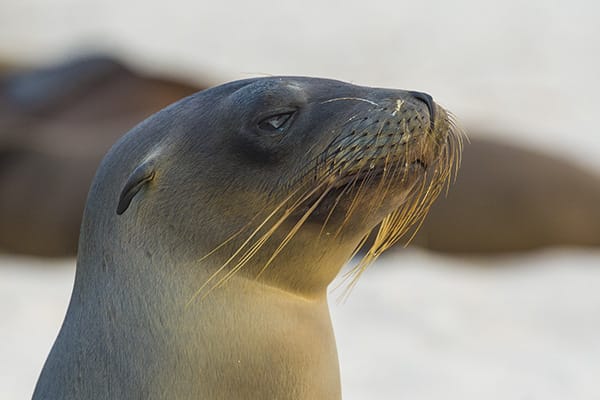
Tortoise Breeding Center & Highlands
AM: You will visit “Fausto Llerena” Tortoise Breeding Center in Puerto Ayora, where giant tortoises are bred in captivity. This is home to tortoises ranging from 3 inches (new hatchlings) to 4-foot-long adults. Subspecies of the giant tortoises interact with one another, and many of the older tortoises are accustomed to humans stretching out their heads for a photo opportunity. The babies are kept until they are about four years old and strong enough to survive on their own.
PM: Accessible by bus from Puerto Ayora, the highlands of Santa Cruz are a deep green which contrasts beautifully with the dry, lower part of the islands. The predominant vegetation in the highlands are Scalesia trees which create a lush green forest. The lava tunnels, over half a mile long, are underground, and walking through them is a unique, surreal experience. At this place, you’ll have lunch.

Suarez Point & Gardner Bay
AM: On the trail to Suarez Point you will have the chance to spot blue-footed boobies, albatrosses, and Nazca boobies. This island is the breeding site of nearly the world’s 12,000 pairs of waved albatrosses. You will also visit a beautiful site on the oceanfront where there is a cliff that the large albatrosses use as a launching pad! You will have the chance to see the famous blowhole that spurts sea water into the air. The landscape is great for photography.
PM: This excursion takes you to the spectacular Gardner Bay. After landing, you can walk across a lovely white-sand beach amongst a busy sea lion colony or dive into the water to swim with sea lion pups. You may also see curious mockingbirds on the beach.
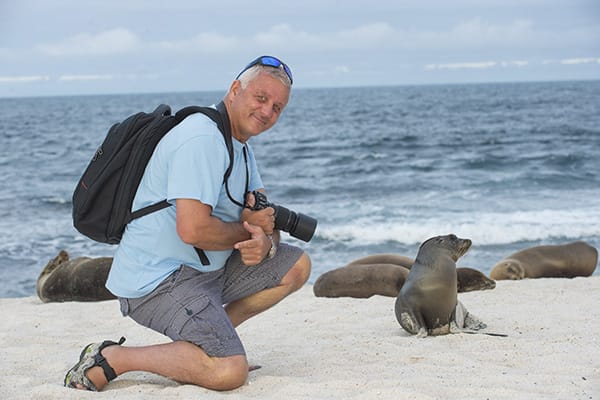
Santa Fe & South Plaza
AM: Santa Fe Island (Barrington) is home to the small picturesque bay and anchorage on the island’s northeast coast. The bay has two visitor trails: one leading to a scenic viewpoint atop a cliff, and the other spanning from a small beach to a tall prickly pear cactus forest.
PM: This small island with steep cliffs was formed by rising lava and is now covered by Opuntia cacti. It is also home to one of the largest sea lion colonies as well as colorful yellow and red land iguanas. The most characteristic plant is the Sesuvium. During the rainy season its color is a greenish to yellowish tone and in the dry season (end of June through January) a bright red.
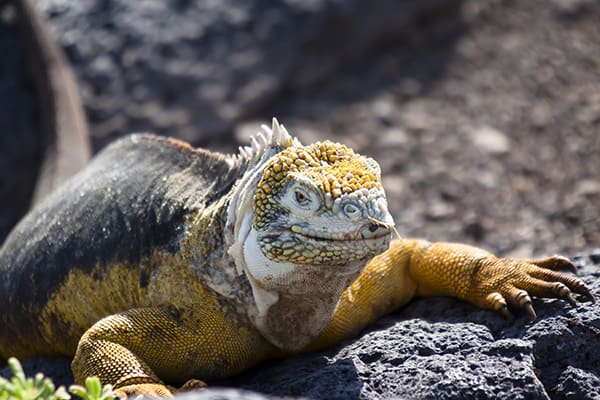
Disembarkation
AM: Visit Black Turtle Cove in the northern part of Santa Cruz. This inlet is surrounded by mangroves and is only accessible by dinghy. The shallow cove is a haven for young marine life. Black-tip and white-tip reef sharks, sea turtles, and a variety of rays are often spotted here.
PM: After this final visit, you will be transferred to the Baltra airport in time for your flight back to the mainland.
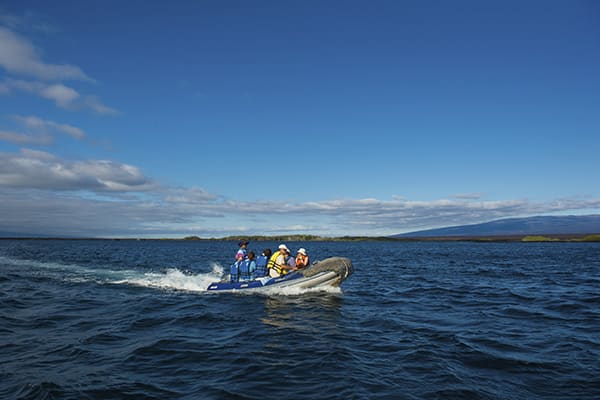
Embarkation
AM: You will arrive at Baltra Island in the morning. After passing through immigration and baggage claim, you will be met by a Galapagos Angel staff member and transferred to the yacht. You will be shown to your cabin where you will have some time to settle in before lunch and a welcome briefing.
PM: Bachas Beach is located on the north shore of Santa Cruz and is a beach for swimming. One of the few remnants of the U.S. World War II presence in the Galapagos, a floating pier, can be seen here. You may see flamingos, Sally Lightfoot crabs, hermit crabs, black-necked stilts, and whimbrels. Sea turtles also nest on the beach.

Mosquera Islet & Dragon Hill
AM: Mosquera Islet is located between the islands of Baltra and North Seymour. This reef of rocks and coral (the result of an uprising) is only 160 meters across at its narrowest width. This island has one of the largest populations of sea lions and is home to many shorebirds. There have been occasional reports at this site of orcas feeding on sea lions.
PM: The visitors’ site at Dragon Hill is located in northwestern Santa Cruz Island and consists of a 1,600 m long trail that runs through three different environments. The beach is very rocky. At high tide it’s a nice place for snorkeling. At this visiting site you can find vegetation of the typical intertidal zone and dry zone.
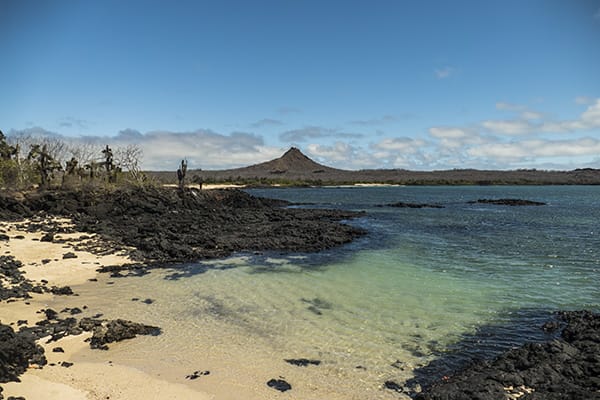
Tagus Cove & Espinoza Point
AM: You will visit Tagus Cove on Isabela Island which is located across from Fernandina Island, near the Bolivar Channel dividing the two islands. This spot has been frequented by ships since the 1800s, using the area as an anchorage site. Trails winding by Lake Darwin up to a ridge display wonderful views.
PM: Crossing the Bolivar Channel that divides Isabela and Fernandina Islands, you will land at Espinoza Point, and after walking past a colony of marine iguanas and a group of sea lions, you will reach the island’s highlight: the flightless cormorant nesting site. This area also provides a great opportunity to see the Galapagos hawk.

Urbina Bay & Elizabeth
AM: Urbina Bay is located at the base of Alcedo Volcano on the west coast between Tagus Cove and Elizabeth Bay. This area experienced a major uplift in 1954 causing the land to rise over 16 feet. The coast expanded half a mile out leaving marine life stranded on the new shore. This area is also a great place for snorkeling.
PM: Elizabeth Bay is located on the east coast of Isabela Island. The bay contains many islets, which can be visited by dinghy. Penguins and blue-footed boobies can be spotted on the rocky islets. With an abundance of marine life and clear water, the area is perfect for snorkeling and viewing schools of colorful fish, sea lions, and perhaps even sharks.

Moreno Point & Port Villamil
AM: Moreno Point is located southwest of Elizabeth Bay. Here a dry landing onto what was once flowing lava is possible. The lava has left craters in its wake which formed crystal tide pools. By looking into the pools, you can peer into another world as the marine life drifts by your window. In the brackish pools of this area, you may see pink flamingos, white-cheeked pintails, and common gallinules. If you look carefully into the pools, you may see white-tip reef sharks and some sea turtles.
PM: This port is home to many native Galapagenians and home to many important visitor sites. The port is surrounded by extensive, white sandy beaches with lagoons and wetlands on its borders. A great place to absorb history and culture, the town also provides shopping opportunities.

Sierra Negra Volcano & Tortoise Breeding Center
AM: Visit to the Sierra Negra Volcano, which is the largest basaltic caldera in the Galapagos with a diameter of 6.2 miles (10 km). The site offers impressive views and the opportunity to observe up to seven species of finches and a rich display of vegetation. The north side of the caldera provides evidence of its most recent volcanic activity in 2005.
PM: Arnaldo Tupiza Breeding Center is located about one mile (1.5 km) from Puerto Villamil. Here, tortoise populations from South Isabela, Sierra Negra Volcano, Cerro Azul, Cazuela, Cinco Cerros, Roca Union, San Pedro, Tables and Cerro Paloma have been bred in captivity. In total there are 330 juvenile and adult tortoises.

Devil's Crown & Cormorant Point
AM: You will have a chance to snorkel around Devil’s Crown which is the rocky remains of an offshore volcano sticking out of the water. This is a great location to spot a wide range of marine creatures.
PM: Cormorant Point hosts a large flamingo lagoon where other birds such as common stilts and white-cheeked pintails can also be seen. The beaches on this island are distinct: The Green Beach is named so due to its green color, which comes from a high percentage of olivine crystals in the sand, and the Flour Sand Beach is composed of white coral.
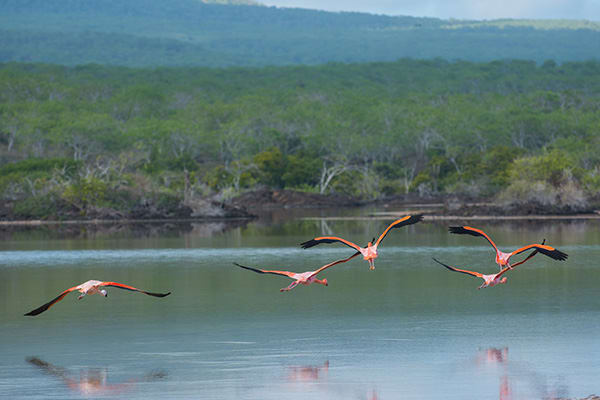
Disembarkation
AM: Daphne Major and Daphne Minor are located between Santa Cruz and Santiago Islands. Most tourists are restricted from visiting these islands by the Galapagos National Park; however, the islands continue to be a popular stop for scientists researching the unique qualities of the Galapagos finches.
PM: After this final visit, you will be transferred to the Baltra airport in time for your flight back to the mainland.

Accommodations
Social Areas





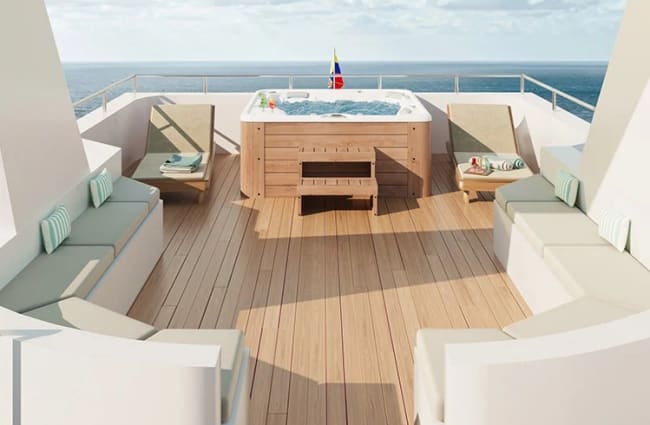

Suites & Cabins


Standard Cabin
The six standard cabins are located on the yacht's Main Deck. Air-conditioned and featuring a safety box, they also come with a fully equipped ensuite. The cabins can be configured as matrimonial or twin as required, ensuring the utmost comfort.




Suite
The more spacious suites are located on the Upper Deck behind the Bridge with easy access to the bar and al-fresco dining area. Air-conditioned and featuring a safety box and TV, they also come with a private bathroom. The suites can similarly be transformed into matrimonial or twin upon request.
Related Cruises
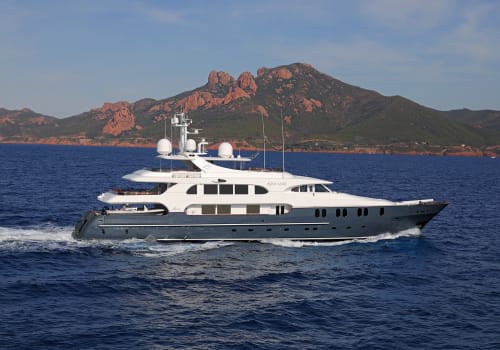
- Galapagos
- Ecuador
Aqua Mare

- Galapagos
- Ecuador
Galaxy Sirius
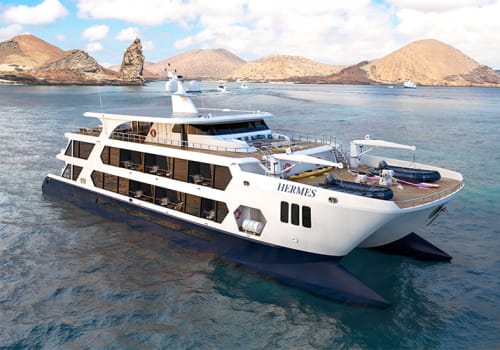
- Galapagos
- Ecuador
Hermes
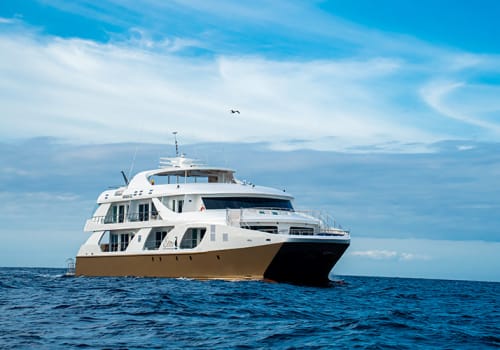
- Galapagos
- Ecuador
Elite
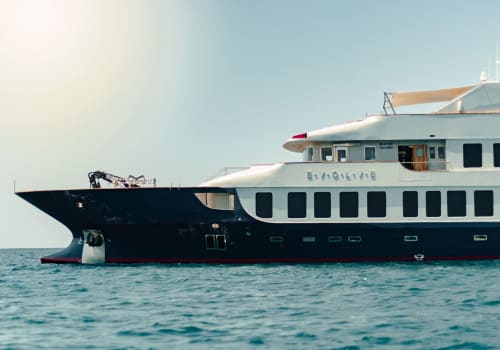
- Galapagos
- Ecuador
Origin, Theory & Evolve

- Galapagos
- Ecuador
Cormorant II
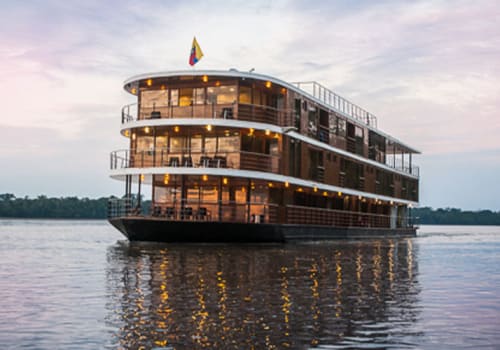
- Amazon
- Ecuador
Anakonda

- Galapagos
- Ecuador
Alya
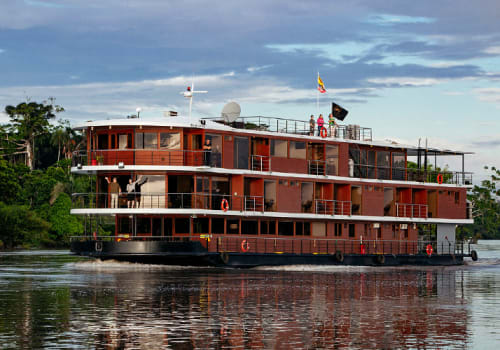
- Amazon
- Ecuador
Manatee Amazon Explorer

- Galapagos
- Ecuador
Endemic
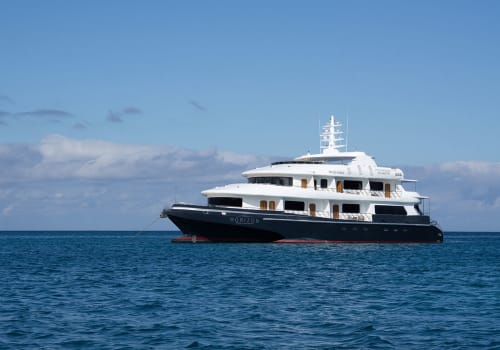
- Galapagos
- Ecuador
Galapagos Horizon

- Galapagos
- Ecuador
Petrel

- Galapagos
- Ecuador

